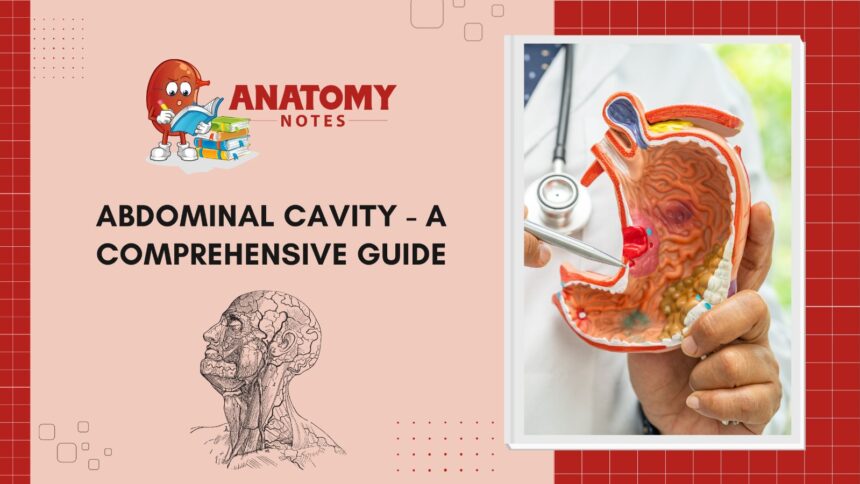Introduction to the Abdominal Cavity
Step into the fascinating world of the abdominal cavity, a vital region in our bodies that plays a crucial role in digestion and overall health. From its anatomy to the functions of its organs, join us on a journey to uncover everything you need to know about this complex yet remarkable area. Let’s explore together!
Anatomy and Boundaries of the Abdominal Cavity
Let’s dive into the fascinating world of the anatomy and boundaries of the abdominal cavity. This crucial part of our body is located between the diaphragm and pelvic inlet, encompassing various organs essential for digestion and metabolism.
The abdominal cavity is divided into different regions, such as the upper abdomen (containing the liver, stomach, and pancreas), lower abdomen (housing the intestines), and pelvic region (where reproductive organs reside). These boundaries provide structure and protection to vital internal organs.
The peritoneum, a thin membrane lining the walls of the abdominal cavity, plays a significant role in supporting and protecting these organs. It helps reduce friction between them during movement or digestion processes.
Understanding these anatomical structures can aid in diagnosing potential issues or diseases affecting this area. Medical professionals rely on this knowledge to perform accurate assessments through physical examinations or imaging techniques like ultrasounds or CT scans.
Organs Within the Abdominal Cavity
The abdominal cavity houses a wide array of vital organs that play crucial roles in the body’s overall function. From the stomach to the liver, each organ has its specific functions and importance. The stomach acts as a reservoir for food before it continues through the digestive tract, while the liver is responsible for detoxifying harmful substances and producing bile for digestion.
Moving on to the intestines, both small and large, they are key players in absorbing nutrients from food and eliminating waste products. The pancreas plays a dual role in producing digestive enzymes and regulating blood sugar levels through insulin secretion. Additionally, the kidneys filter waste from the blood to form urine, maintaining electrolyte balance.
These organs work harmoniously together to ensure proper digestion, nutrient absorption, waste elimination, and metabolic regulation within the body’s intricate system.
Functions of the Abdominal Organs
The abdominal organs play vital roles in the body’s functions. The stomach churns and breaks down food with its acids and enzymes, preparing it for further digestion. The liver filters toxins from the blood and produces essential proteins. The pancreas secretes digestive enzymes and regulates blood sugar levels.
The small intestine absorbs nutrients from digested food, while the large intestine reabsorbs water and forms waste products for elimination. The gallbladder stores bile produced by the liver to aid in fat digestion. Each organ contributes uniquely to maintaining overall health and well-being.
The intricate coordination between these organs ensures proper digestion, absorption of nutrients, detoxification, and waste elimination processes within the body. Understanding their functions helps us appreciate the complexity of our abdominal cavity’s inner workings.
Peritoneum: The Protective Membrane
The peritoneum is a remarkable protective membrane that lines the abdominal cavity. It consists of two layers: the parietal peritoneum which lines the abdominal wall, and the visceral peritoneum which covers the abdominal organs. This double-layered structure not only provides protection but also allows for smooth movement of organs during digestion and other bodily functions.
One interesting fact about the peritoneum is its ability to secrete a small amount of fluid that acts as lubrication, reducing friction between organs. This fluid also helps in immune defense by containing antibodies and white blood cells to fight off infections.
In addition to its protective role, the peritoneum plays a crucial part in transporting nutrients and waste products throughout the body. Its rich network of blood vessels ensures efficient nutrient absorption and waste removal.
Understanding the importance of this intricate membrane sheds light on how our bodies maintain homeostasis and function optimally.
Vascular Supply and Nerve Innervation
The abdominal cavity is a bustling hub of activity, with a complex network of blood vessels and nerves ensuring everything runs smoothly.
Vascular supply to the abdominal organs is vital for delivering oxygen and nutrients essential for their proper function. The major arteries like the celiac trunk, superior mesenteric artery, and inferior mesenteric artery branch out to supply different regions within the abdomen.
Nerve innervation in the abdominal cavity comes from various sources, including the sympathetic and parasympathetic nervous systems. These nerves play a crucial role in regulating organ functions such as digestion, movement of food through the intestines, and pain perception.
Understanding the intricate interplay between vascular supply and nerve innervation is key to diagnosing and treating abdominal issues effectively. Specialists rely on this knowledge to pinpoint underlying causes of disorders or diseases that may affect these systems.
Common Disorders and Diseases
The abdominal cavity is susceptible to various disorders and diseases that can affect the organs within it. Conditions like appendicitis, gastritis, and ulcers can cause significant discomfort and require medical attention. Inflammatory bowel diseases such as Crohn’s disease and ulcerative colitis are chronic conditions that can impact digestion and overall health.
Gallstones, kidney stones, and liver diseases are also common issues that affect the abdominal region. These conditions often present with symptoms like pain, bloating, nausea, or changes in bowel habits. It is essential to seek timely diagnosis and treatment for any abdominal concerns to prevent complications.
Certain lifestyle factors such as poor diet, lack of exercise, smoking, and excessive alcohol consumption can contribute to the development of abdominal disorders. Maintaining a healthy lifestyle through balanced nutrition and regular physical activity plays a crucial role in preventing these issues from arising.
Regular check-ups with healthcare providers are important for early detection of any potential problems in the abdominal cavity. Be proactive about your health by addressing any concerning symptoms promptly to ensure optimal well-being.
Diagnostic Techniques for Abdominal Issues
When it comes to diagnosing abdominal issues, healthcare providers have a variety of techniques at their disposal. One common method is physical examination, where the doctor assesses symptoms and palpates the abdomen for any abnormalities.
Imaging studies such as ultrasounds, CT scans, and MRIs are also valuable tools in identifying underlying conditions within the abdominal cavity. These non-invasive procedures provide detailed images that help in making an accurate diagnosis.
Blood tests can offer insights into organ function and detect any signs of infection or inflammation. Stool samples may be analyzed to check for parasites or gastrointestinal bleeding.
In some cases, more invasive procedures like endoscopy or laparoscopy may be necessary to directly visualize the internal structures of the abdomen and obtain tissue samples for further evaluation. These techniques play a crucial role in determining the best course of treatment for patients with abdominal issues.
Surgical Interventions and Procedures
When it comes to surgical interventions and procedures related to the abdominal cavity, there are various techniques and approaches that healthcare professionals may utilize.
From minimally invasive laparoscopic surgeries to more complex open procedures, each method is tailored to address specific conditions or disorders affecting the abdominal organs.
Surgeons specializing in abdominal surgery undergo rigorous training to ensure precision and safety during these intricate procedures. Their expertise plays a crucial role in achieving successful outcomes for patients requiring surgical intervention.
Advancements in technology have also revolutionized how abdominal surgeries are performed, leading to shorter recovery times and reduced post-operative discomfort for individuals undergoing treatment.
It’s essential for patients facing potential surgical interventions within the abdominal cavity to collaborate closely with their healthcare team, discussing all options available and understanding the risks and benefits associated with each procedure.
Importance of Nutrition and the Abdominal Cavity
Understanding the importance of nutrition for your abdominal cavity is crucial for maintaining overall health. The food you consume directly impacts the organs within this vital area of your body, affecting their functions and well-being.
A balanced diet rich in nutrients such as fiber, vitamins, and minerals plays a significant role in supporting proper digestion and metabolism. These essential components help keep your gastrointestinal system running smoothly, preventing issues like constipation or indigestion.
Consuming adequate amounts of water also aids in digestion by keeping things moving through your intestines efficiently. Hydration is key to ensuring that waste products are eliminated properly from your body, reducing the risk of bloating or discomfort.
Furthermore, incorporating probiotics into your diet can promote a healthy gut microbiome, which is essential for optimal functioning of the digestive system. Foods like yogurt, kefir, and sauerkraut contain beneficial bacteria that support overall gut health and improve nutrient absorption.
Incorporating a variety of whole foods into your meals not only nourishes your body but also supports the intricate processes happening within your abdominal cavity every day. Prioritizing nutrition ensures that these vital organs have the fuel they need to function at their best capacity.
Physiology of Digestion and Absorption
Understanding the physiology of digestion and absorption is essential for maintaining optimal health. The process starts in the mouth, where enzymes begin breaking down food into smaller molecules. As food travels through the esophagus to the stomach, gastric juices further break it down before moving to the small intestine.
In the small intestine, nutrients are absorbed into the bloodstream through tiny villi lining its walls. This absorption process is crucial for providing our bodies with energy and essential nutrients needed for various bodily functions.
The large intestine then absorbs water and electrolytes from any remaining indigestible food particles before excretion. A healthy digestive system plays a vital role in overall well-being by ensuring proper nutrient uptake and waste elimination.
Advancements in Abdominal Research and Medicine
Advancements in abdominal research and medicine have revolutionized the way we diagnose and treat conditions affecting the abdominal cavity. With cutting-edge technologies like laparoscopy and robotic surgery, surgeons can now perform complex procedures with greater precision and minimal invasiveness.
Research in areas such as microbiome studies has shed light on the intricate relationship between gut bacteria and overall health. This knowledge is paving the way for innovative treatments targeting specific microbial imbalances to improve digestive health.
Furthermore, advancements in imaging techniques like MRI and CT scans allow healthcare providers to visualize internal organs with exceptional detail, aiding in early detection of abnormalities.
Innovative drug therapies are also being developed to target conditions such as inflammatory bowel disease, providing patients with more effective treatment options. The future of abdominal medicine holds great promise as researchers continue to push boundaries in understanding abdominal physiology and pathology.
Conclusion
As we wrap up our exploration of the abdominal cavity, it becomes clear that this intricate part of the body plays a crucial role in maintaining health and well-being. From the organs it houses to the protective peritoneum that surrounds them, every aspect serves a purpose in ensuring optimal bodily function.
The anatomy and physiology of the abdominal cavity are fascinating subjects that continue to intrigue researchers and medical professionals alike. Advancements in technology have allowed for greater understanding and more effective treatments for various abdominal disorders.
Whether it’s diagnostic techniques or surgical interventions, experts work tirelessly to improve outcomes for patients facing abdominal issues. Nutrition also plays a vital role in supporting digestive health and overall wellness.
As we look ahead, ongoing research promises even more insights into how we can better care for this essential part of our bodies. The journey through the complexities of the abdominal cavity is far from over, with new discoveries waiting just around the corner.
Frequently Asked Questions (FAQs)
Q: Can abdominal cavity issues be prevented?
A: Maintaining a healthy lifestyle, including a balanced diet and regular exercise, can help prevent many abdominal problems.
Q: What are some common symptoms of abdominal cavity disorders?
A: Symptoms can vary depending on the specific condition but may include pain, bloating, nausea, vomiting, and changes in bowel habits.
Q: How important is early detection of abdominal diseases?
A: Early detection is crucial for successful treatment outcomes. Regular check-ups and screenings can help catch potential issues before they become serious.
Q: Are there any non-invasive diagnostic techniques available for abdominal issues?
A: Yes, advancements in technology have led to less invasive diagnostic methods such as ultrasounds, CT scans, and MRIs that provide detailed images of the abdomen.
Q: What role does nutrition play in maintaining a healthy abdominal cavity?
A: A well-balanced diet rich in fiber, fruits, vegetables, lean proteins, and whole grains can support digestive health and reduce the risk of developing certain abdominal conditions.
Whether you’re looking to learn more about the anatomy of the abdominal cavity or seeking information on how to keep your digestive system healthy, this comprehensive guide has covered everything you need to know. Stay informed about your body’s inner workings and take care of your abdomen for overall well-being.




